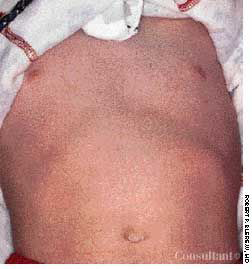Scarlet Fever Rash
Rarely encountered these days, scarlet fever is believed to be caused by sensitization to an erythrogenic toxin produced by strains of group A beta-hemolytic streptococci.

Rarely encountered these days, scarlet fever is believed to be caused by sensitization to an erythrogenic toxin produced by strains of group A beta-hemolytic streptococci. Thus, previous exposure to the toxin is necessary for development of the rash seen here-fine, sandpaper-like and papular on an erythematous background (Figure). It usually begins on the trunk and spreads over the entire body within hours or days. Scarlet fever is unusual in infancy, possible because of maternal transfer of antibodies.
This 5-year-old girl's pharynx was injected, and a group A beta-hemolytic streptococcal antigen test had a positive result. The child was given penicillin V orally, 250 mg twice daily, and the rash cleared completely within several days. Parents should be warned that the child's skin may desquamate as the last stage of healing-usually after 1 to 2 weeks.